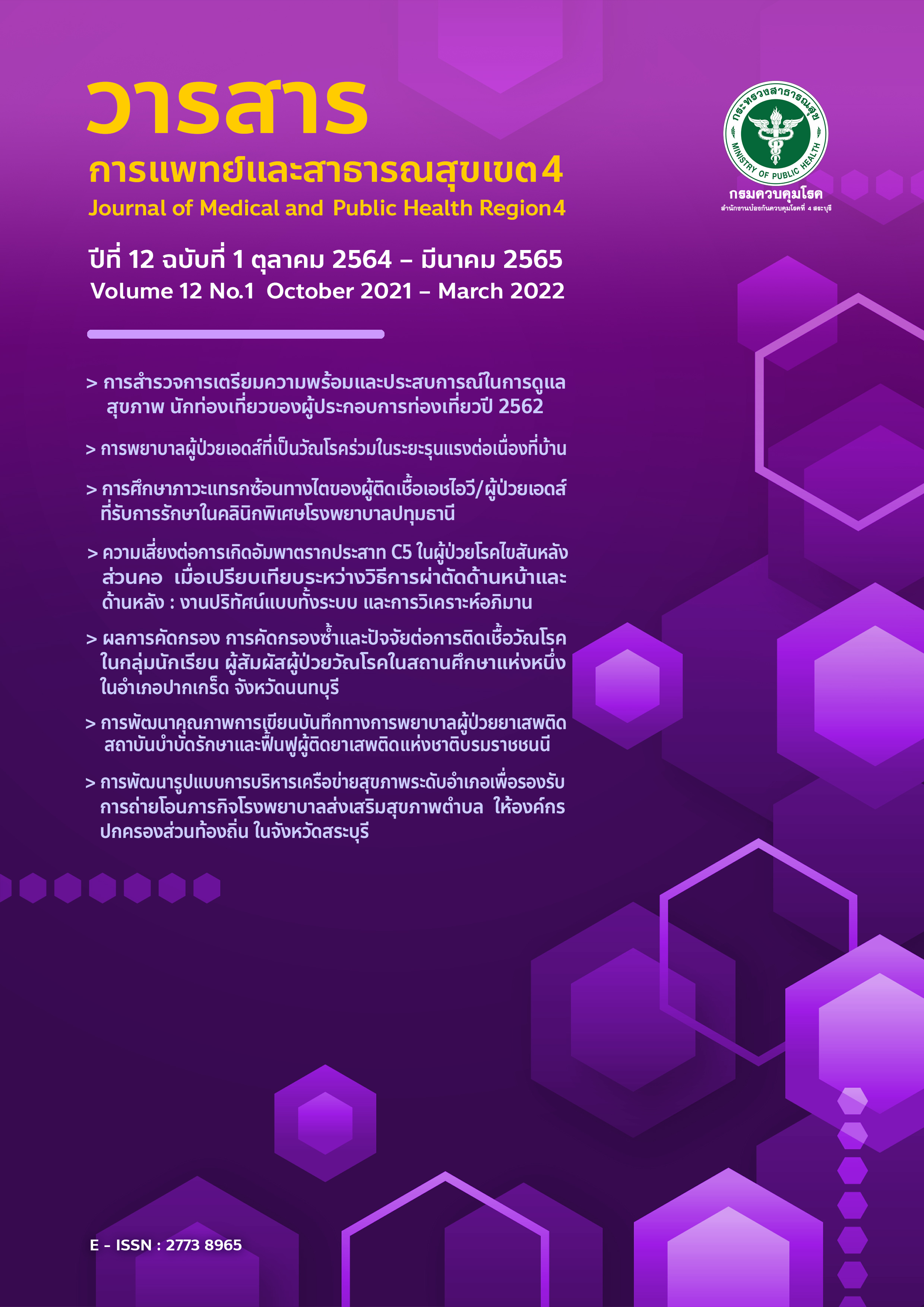Nursing care of AIDS patients with severe concomitant tuberculosis at home : Case Study
Main Article Content
Abstract
Being sick with AIDS damages the body's immune system After being infected with HIV and getting opportunistic infections causing a faster death, the risk of developing TB increases 113 to 170 times The concept of health promotion theory of pender and the process of nursing long term patients at home (home health care) is applied for patients to recive continuous care Patients eating on time regularly and not refusing AIDS and tuberculosis drugs have the result of health enhancing behaviors allowing independent self care with complications and reducing the spreading of TB within families and communities Also a holistic nursing plan would be implemented to evaluate a patients health condition which would cover physical health, mental health and social abilities In a holistic nursing plan a diagnoses would be made for the patients condition than a plan would be created relating to their needs Throughout this process a new innovative way to record medication intake would be used as well Information can also be forwarded to multidisciplinary teams and agencies that are willing to help with various issues From this case study, it was found that providing comprehensive and continuous nursing care for multidimensional patients based on the patient, family and community allows for patients to have a good quality life
Article Details

This work is licensed under a Creative Commons Attribution-NonCommercial-NoDerivatives 4.0 International License.
References
ศูนย์รวมข้อมูลสารสนเทศด้านเอชไอวีของประเทศไทย. คาดประมาณผู้ติดเชื้อเอชไอวี ปี 2563 [อินเทอร์เน็ต]. [เข้าถึงเมื่อ 16 ตุลาคม 2564]. เข้าถึงได้จาก: https://hivhub.ddc.moph.go.th/epidemic.php.
ลัดดา พลพุทธา. การพยาบาลผู้ป่วยติดเชื้อเอชไอวี.วารสารโรงพยาบาลสกลนคร 2560; 21: 136-150.
กรมควบคุมโรค. สถานการณ์วัณโรค global tuberculosis report [อินเทอร์เน็ต]. [เข้าถึงเมื่อ 16 ตุลาคม 2564]. เข้าถึงได้จาก: https://www.hfocus.org/content/2019/09/17640.
จุฬาวรรณ จิตดอน. บทบาทของพยาบาลเวชปฏิบัติชุมชนเพื่อส่งเสริมการดูแลผู้ป่วย วัณโรคปอดที่บ้านโดยเน้นครอบครัวเป็นศูนย์กลาง.วารสารมหาวิทยาลัยหัวเฉียว 2561; 22: 180-192.
ณัฏฐนันท์ ภูวิภิรมย์. การศึกษาสาเหตุของการเสียชีวิตของผู้ติดเชื้อเอชไอวี/เอดส์ที่เข้ารับการรักษาในโรงพยาบาลสมุทรสาคร.วารสารแพทย์เขต 4-5 2559; 35: 2-12.
คณิสร แก้วแดง, สุมาลี ราชนิยม. พยาบาลกับการดูแลผู้ป่วยเอดส์แบบองค์รวม. วารสารวิทยาลัยพระปกเกล้า 2558; 26: 128-134.
ประเทือง ธราธรรุ่งเรือง. การพยาบาลผู้ป่วยวัณโรคในงานบริการผู้ป่วยนอก.วารสารวิทยาลัยพยาบาลพระจอมเกล้า 2561; 1: 77-95.
พนารัตน์ วิศวเทพนิมิต,กมลรัตน์ เทอร์เนอร์. การดูแลแบบองค์รวมและการบริการสุขภาพด้วยหัวใจ ความเป็นมนุษย์: กรณีศึกษาผู้ติดเชื้อเอชไอวีและผู้ป่วยเอดส์ที่สถาบันบำราศนราดูร.วารสารวิจัยระบบสาธารณสุข 2560; 11: 401-412.
ชุลีกร ด่านยุทธศิลป์. แบบจำลองการส่งเสริมสุขภาพเพนเดอร์และการประยุกต์ใช้ในการปฏิบัติการส่งเสริมสุขภาพทางการพยาบาล. วารสารพยาบาลสงขลานครินทร์ 2561; 38: 132-141.
Pender NJ, Murdaugh CL, Parsons MA. Health promotion in nursing practice. 6th ed. Boston: Pearson; 2011.
Alkhalaileh MA, Khaled MHB, Baker OG, et al. Pender’s health promotion model: An integrative literature review. ME-JN. 2011; 5(5): 12-22. doi: 10.5742/MEJN.2011.55104
สุรีย์ ธรรมิกบวร. ทฤษฎีการส่งเสริมสุขภาพของเพนเดอร์ [อินเทอร์เน็ต]. [เข้าถึงเมื่อ 10 สิงหาคม 2564]. เข้าถึงได้จาก :https://www.nurse.ubu.ac.th/sub/knowledgedetail/PD.pdf
วรณัน ประสารอธิคม. แนวคิดการดูแลสุขภาพที่บ้าน (Concept of home care) [อินเทอร์เน็ต]. [เข้าถึงเมื่อ 10 สิงหาคม 2564]. เข้าถึงได้จาก https://med .mahidol.ac.th/um/sites/default/files/public/pdf.


